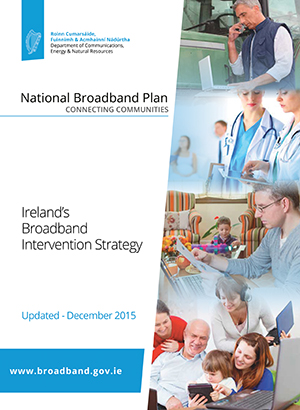Delivering rural broadband

An overview of the strategy that aims to deliver high-quality broadband infrastructure to Ireland’s rural areas.
 The National Broadband Plan (NBP) has set aside €275 million for network build-out. Currently commercial investment in the sector means that high speed services are now available to approximately 1.2 million premises in Ireland and by the end of 2016 it is envisaged that 70 per cent of premises and 1.6 million properties will have access to high quality broadband. This intervention strategy focuses on ensuring the delivery of high speed broadband infrastructure to the remaining 757,000 addresses in the country where there is no certainty of commercial investment.
The National Broadband Plan (NBP) has set aside €275 million for network build-out. Currently commercial investment in the sector means that high speed services are now available to approximately 1.2 million premises in Ireland and by the end of 2016 it is envisaged that 70 per cent of premises and 1.6 million properties will have access to high quality broadband. This intervention strategy focuses on ensuring the delivery of high speed broadband infrastructure to the remaining 757,000 addresses in the country where there is no certainty of commercial investment.
It was developed following discussions with industry and key stakeholders and guided by the EU Digital Agenda for Europe that envisages all EU citizens having access to constant speeds of at least 30Mbps by 2020. Delivering high speed broadband to rural Ireland will present a challenge as Ireland has one of the lowest population densities in Europe. This low density, coupled with a thinly distributed rural population makes the deployment of high speed broadband network infrastructure challenging and costly.
Objectives
The intervention strategy’s vision is informed by the fact that Ireland’s digital economy represents 5 per cent of the nation’s GDP and is anticipated to grow to 10 per cent by 2020. Building on the vision for a digitally enabled economy this state led intervention has the following key objectives:
1. secure a national high speed broadband network for Ireland as quickly as possible;
2. to ensure every home and business has access to high speed broadband with a choice of service providers;
3. to ensure that the network can meet current and future demands;
4. to maximise the re-use of existing infrastructure;
5. to incentivise additional commercial investment;
6. to stimulate growth and retention in jobs while enabling e-farming, e-health, trading online, e-education, tourism and savings for consumers.
These objectives mean that high quality and reliable broadband services will be provided, value for money will be achieved and government policy on economic recovery and jobs will be supported.
In order to establish the extent of intervention needed and ensure that public funds are not being spent in areas where commercial investment is forthcoming, a detailed mapping exercise of current and planned high speed broadband deployment has been carried out. The development of this updated map has involved public consultation, engagement with industry and an assessment of notified commercial investment plans. The High Speed Broadband Map 2020 also provides a measure of certainty to bidders with regards to the intervention area for procurement and will ensure that citizens and business have access to reliable, future proofed services. The strategy requires the build-out of a wholesale, open access network capable of meeting defined minimum standards, these are:
• a minimum of 30Mbps download;
• a minimum of 6Mpbs upload or twice the maximum upload speed of existing broadband in the intervention area, whichever is greater;
• a latency of no more than 25 milliseconds;
• a jitter of no more than 25 milliseconds;
• packet loss of no more than 0.1 per cent;
• a guaranteed service availability rate of 99.95 per cent.
 Similarly, the winning bidders must also ensure the availability of a range of high quality wholesale services to allow retail competition to develop. Given the commercial challenges of investing in the intervention area, it is envisaged that these communities will be supported by one high speed network rather than the range of networks that are available in some commercial areas.
Similarly, the winning bidders must also ensure the availability of a range of high quality wholesale services to allow retail competition to develop. Given the commercial challenges of investing in the intervention area, it is envisaged that these communities will be supported by one high speed network rather than the range of networks that are available in some commercial areas.
The intervention model will need to ensure that retailers have a choice of retail service providers and can avail of affordable and competitive high speed broadband services. To achieve this, the strategy proposes that the intervention will fund the building of a wholesale, open access network allowing retail companies to access it on transparent and equal terms.
In terms of network ownership a decision is yet to be made. However, following consultation with stakeholders and appraisal from both a financial and non-financial perspective, the two preferred options are, a commercial stimulus model and a concession type arrangement where a commercial company designs, builds and owns the network for the duration of the contract with the asset then reverting to the state at the end of the contract. A decision on which model will be selected will be made before the issuing of the private tender documents.
The funding needed for the network build is still to be decided but will be guided by detailed network modelling, financial analysis and engagement with the industry. The European Investment Bank (EIB), Ireland Strategic Investment Fund (ISIF) and the European Fund for Strategic Investment (EFSI) have all expressed an interest in funding commercial aspects of the project. Government contribution towards the cost of delivering the network will be achieved through a combination of exchequer, EIB and EFSI sources with €75 million already committed under the European Regional Development Fund.
Time frame
The rollout of the network will prove challenging in both a logistical and fiscal sense as the intervention area currently covers 96 per cent of the country and 100,000 km of road. Despite this, the strategy envisages that the network will be operational within five years of the contract being awarded.
Customers in the intervention area stand to realise very significant economic benefits from the availability of high speed broadband. The stronger the demand for services, the lower the likely cost of the intervention to the state and as such, bidders will be required to show how they intend to encourage early adoption and commit to such measures. They will also be expected to outline how they propose to engage with communities on the benefits of the network and availability in their area.
To ensure that adoption is affordable the department wants as many premises as possible to be connected during the deployment stage. This will serve a dual purpose of lowering connection costs and stimulating demand for services. Similarly, bidders will be asked to outline their connection costs to premises and set out a standard wholesale connection cost for existing premises. This will ensure that consumers pay no more than the standard connection charge set out in the bidding process. Recognising that new premises will be built over the lifetime of the strategy, the department will also ask bidders to commit to providing high speed broadband services on request to all premises.
Delivering on this vision will, it is hoped, make Ireland a global leader in the provision of ubiquitous high speed broadband which will open up opportunities, locally, nationally and internationally. The implications for Ireland of the intervention are likely to be wide ranging and include positive impacts on job creation, improved business productivity, faster deployment and take-up of new services. It will lead to increased competition in the provision of high speed broadband services.





